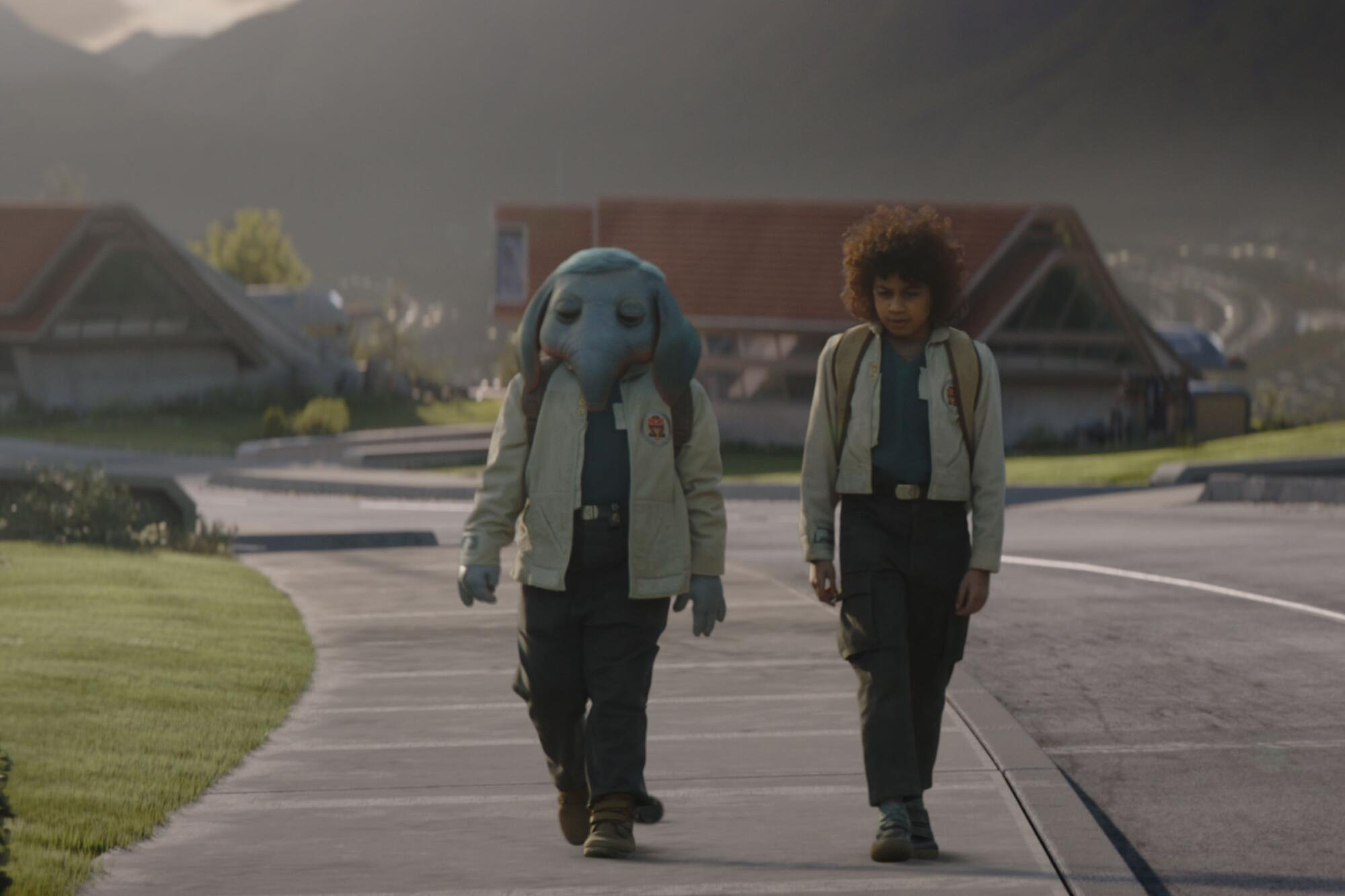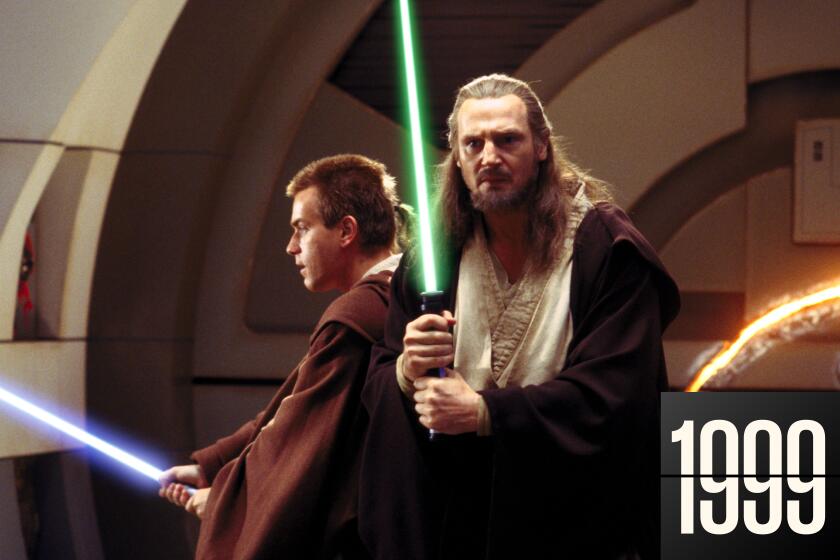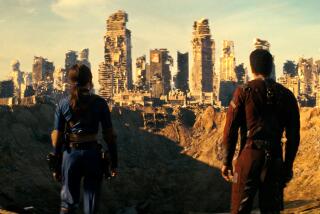
- Share via
This story contains spoilers for “Star Wars: Skeleton Crew” Episode 3.
There’s more to At Attin than meets the eye.
The peaceful and orderly planet introduced in “Star Wars: Skeleton Crew” is not just the suburban homeworld of Wim (Ravi Cabot-Conyers), Neel (Robert Timothy Smith), Fern (Ryan Kiera Armstrong) and KB (Kyriana Kratter). The third episode of the Disney+ series reveals that At Attin is a mythical planet that has been hidden from the galaxy since long before the events of the original “Star Wars” trilogy and the war between the Empire and Rebellion.
Described as one of the “Jewels of the Old Republic,” At Attin is among the “planets of wonder” that were “hidden for their own protection.” According to Kh’ymm (voiced by Alia Shawkat), who was tapped to help the lost kids trying to find a way home, it’s the only one of these planets that wasn’t destroyed long ago.
“The Mandalorian,” “Ahsoka” and 25 years of spinoffs show the stealth power of George Lucas’ 1999 prequel, which, for all its controversy, laid the groundwork.
This means that even though the series, like “The Mandalorian,” is set during the time of the New Republic — i.e. after the events of the original “Star Wars” trilogy — At Attin’s origins are rooted in an era that spanned for thousands of years before it.
The latest revelation is “just the tip of the iceberg,” says Jon Watts, the head writer and executive producer of “Skeleton Crew” along with Christopher Ford. “There’s so many little reveals and twists and turns along the way.”

“Skeleton Crew,” which premiered earlier this month, follows a quartet of kids who are trying to find their way home after being unexpectedly flung into the galaxy on an old starship they stumbled upon in the woods in their neighborhood. Accompanying them are a grumpy droid (Nick Frost) that they found aboard the starship and a mysterious, Force-sensitive scoundrel (Jude Law) who they met at a spaceport of scum and villainy.
“We liked the idea of a group of kids that don’t know that much about the ‘Star Wars’ galaxy getting lost in the ‘Star Wars’ galaxy,” says Watts. They’re “experiencing it for the first time [in] the story of their journey home.”
For these specific kids, home is At Attin, where they live in neighborhoods with tract housing and lawns, take the bus or their bikes to school and interact with various service droids. In At Attin, Wim is a latchkey kid who dreams of Jedi adventures with his reliable best friend Neel. Fern is a bit more rebellious, often zipping through the streets on her speeder with her best friend KB.
But it‘s not long after the kids find themselves out in space that there are hints that At Attin is no ordinary place, including how others react to the planet’s name as well as to Wim’s retro lunch money.
Watts and Ford had envisioned the kids’ hometown as a place that they would want to leave “not because it was dystopian or … so desolate” — like Luke Skywalker’s Tatooine or Rey’s Jakku — but because of its “benign conformity.”
“The houses are all kind of the same, it’s safe and everyone has what feels like a boring job,” says Watts. “School is boring and you don’t want to do homework. You know that there’s a bigger adventure out there somewhere. You just don’t know how to get it.”

It was while they were working through the designs and layout of the homes and neighborhoods that At Attin developed into a suburb.
“I wanted the houses to be really cool and ‘Star Wars’-y,” says Ford. “We had a bunch of different designs, but we couldn’t really judge them until we put them in a row. And when you have them in a row, it totally changed how they felt … As soon as you put them in a row, it creates just this immediate quick read of suburbs.”
‘The Acolyte’s’ cancellation — though not quite unexpected — is still a blow for ‘Star Wars’ that dampens hopes for the franchise’s future.
For At Attin, says production designer Doug Chiang, the “Skeleton Crew” team started with a place “that was somewhat familiar in terms of what ‘Star Wars’ design is, but twisting it a little bit.”
“Suburban Star Wars is something that we’ve never seen before,” Chiang explains. “But the aesthetic was also locked away in time because the planet was hidden.” This meant they were able to lean into the 1970s and ’80s aesthetic of the original “Star Wars.”
The pop cultural touchstones that both Chiang and his fellow production designer Oliver Scholl mention are “E.T. the Extra-Terrestrial” (1982) and “The Goonies” (1985). But beyond these universally recognized neighborhoods, they also looked at real-life places including the retrofuturistic Brasilia, the brutalist architecture at an Armenian airport and the works of architects like Kenzo Tange and Tadao Ando for inspiration.

Because the kids being bored on At Attin is key to the story, the production designers had to resist the urge to be overly playful.
“It can’t be too exciting, because we need to transport that idea across to the audience that this is mundane,” says Scholl. “But it’s mundane in a ‘Star Wars’ context. So it has to be exciting, but still carry across [that] they want to see what’s out there beyond the screen in the sky.”
Plus, the design of At Attin had to fit naturally into the ever-expanding world of “Star Wars.”
“The designs have to speak to a broader universe and it has to make sense,” says Chiang. “A lot of the homework that we do is really to make sure that we figure out all the logic in terms of the evolution of each of these places so that there is an inherent internal logic to ‘Star Wars’ that makes sense within the world we’re developing.”
Practically, At Attin‘s design took cues from urban planning, with consideration given to where housing would be in relation to people‘s workplaces, residents’ commuting needs and even water sources.
What’s “really great about ‘Star Wars’ in general is that it’s a lived-in future,” says Scholl. “It’s not this abstract, everything is chic and clean and it doesn’t feel real. You can imagine that [At Attin has] been there for a long time. That many generations of kids have been born there and went to that school there.”

Scholl explains that At Attin features a rectilinear grid plan city center, wrapped by suburbia in a more circular pattern that “is recognizable from space.” Without mentioning specifics, he hints that at least some of the design is related to At Attin’s larger mysteries.
When asked about what other secrets At Attin may harbor, Watts teases that “we made choices for a reason.”
“Us choosing to create At Attin the way it is, and it having similarities to suburbs, there’s a kind of a nostalgia to that,” says Ford. “But in a lot of media, a lot of stories, suburbs are also hiding something. There’s a darker side to it, and that’s all intentional.”
More to Read
The complete guide to home viewing
Get Screen Gab for everything about the TV shows and streaming movies everyone’s talking about.
You may occasionally receive promotional content from the Los Angeles Times.









